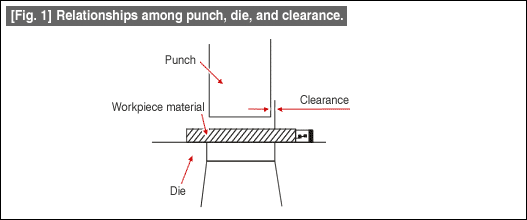HOME > Press Dies Tutorial > #005 Clearance in the Blanking Operation
Press Dies Tutorial
#005 Clearance in the Blanking Operation
Category : Die Design
August 7, 2009
Clearance is the gap between the punch and the die as shown in Fig. 1.

If the clearance becomes large, although the force necessary for blanking will be small, the shear droop of the cut cross-section and the inclination of the fracture cross-section shown in Fig. 2 both become large.

The clearance values of the blanking operation are given in Table 1.
| [Table 1] Blanking clearance for different materials (as a % with respect to plate thickness) |
|
| 1. | For ordinary blanking, a larger clearance value is used as the plate thickness increases. | |
| 2. | A smaller value is used when the blanking conditions are good such as for round holes, etc. | |
| 3. | A larger value is used when the blanking conditions are bad such as for square holes, etc. | |
| 4. | Secondary shear occurs easily if a small value is used for thick plates or for hard materials. | |
| 5. | Use a small value (use precision blanking, if possible) in the case of cutting operations. |
Conventionally, although it was considered good to prepare so that the clearance is uniform in all parts, recently it is considered good to change the clearance partially to suit the changes in the cutting conditions, thereby taking measures against wear of the punch and die, and against distortion of the product.
- #167 Problems in Punching and their Countermeasures (6) Scrap Processing in Punching
- #166 Problems in Punching and their Countermeasures (5) Trimming of Drawn and Shaped Parts
- #165 Problems in Punching and their Countermeasures (4) Scrap Clogging in Punching
- #164 Problems in Punching and their Countermeasures (3) Bending and Twisting of Narrow Punched Parts
- #163 Problems in Punching and their Countermeasures (2) Bending due to Punching



